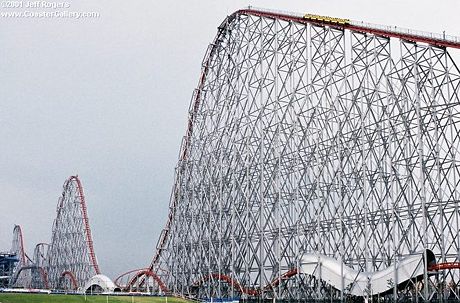Roller coaster: Difference between revisions
imported>Charles Sandberg No edit summary |
imported>Charles Sandberg No edit summary |
||
| Line 3: | Line 3: | ||
[[Image:SD1.jpg|460px|thumb|right|Steel Dragon 2000 roller coaster in [[Nagasaki]], [[Japan]], one of the tallest in the world.<br><small>©[http://www.coastergallery.com/ CoasterGallery.com] (Used by [http://en.citizendium.org/wiki/Image_talk:SD1.jpg/Permission permission])</small>]] | [[Image:SD1.jpg|460px|thumb|right|Steel Dragon 2000 roller coaster in [[Nagasaki]], [[Japan]], one of the tallest in the world.<br><small>©[http://www.coastergallery.com/ CoasterGallery.com] (Used by [http://en.citizendium.org/wiki/Image_talk:SD1.jpg/Permission permission])</small>]] | ||
A '''Roller coaster''' is an amusement ride designed for amusement parks and modern theme parks. It consists of an elevated [[railway]] that carries a train through changes in speed and direction. The | A '''Roller coaster''' is an amusement ride designed for amusement parks and modern theme parks. It consists of an elevated [[railway]] that carries a train through changes in speed and direction. The entertainment of the ride is provided by the [[velocity]] of the descent as well as features such as inverted loops, banked curves, and barrel rolls that produce [[g-force]]s, pressing down on the riders. "Negative g-forces" give the rider a sense of weightlessness at the peak of hills. | ||
At first glance, connected roller coaster cars look much like a passenger train. But unlike a train, it is not powered by a motor, but by [[gravity]] and momentum. To build up the ride's momentum it must first climb the first hill (or lift hill) by use of a lifting mechanism called a ''chain lift''. The lift usually consists of one or more chains running under the track. The chain is fastened in a loop and wound around a motor-powered gear at both ends of the hill. The motor turns the chain loop, propelling the coaster train up the hill like a conveyor belt. The cars are attached to the chain by several hinged hooks called chain dogs. In recent designs, the use of catapult-launching techniques is sometimes implemented. | At first glance, connected roller coaster cars look much like a passenger train. But unlike a train, it is not powered by a motor, but by [[gravity]] and momentum. To build up the ride's momentum it must first climb the first hill (or lift hill) by use of a lifting mechanism called a ''chain lift''. The lift usually consists of one or more chains running under the track. The chain is fastened in a loop and wound around a motor-powered gear at both ends of the hill. The motor turns the chain loop, propelling the coaster train up the hill like a conveyor belt. The cars are attached to the chain by several hinged hooks called chain dogs. In recent designs, the use of catapult-launching techniques is sometimes implemented. | ||
== Origins == | |||
== Development in the United States == | |||
== Expansion in the United States == | |||
== Steel coasters are introduced == | |||
== Modern advancements == | |||
== Physics of roller coasters == | |||
== Roller coaster types == | |||
Revision as of 18:13, 1 August 2008

©CoasterGallery.com (Used by permission)
A Roller coaster is an amusement ride designed for amusement parks and modern theme parks. It consists of an elevated railway that carries a train through changes in speed and direction. The entertainment of the ride is provided by the velocity of the descent as well as features such as inverted loops, banked curves, and barrel rolls that produce g-forces, pressing down on the riders. "Negative g-forces" give the rider a sense of weightlessness at the peak of hills.
At first glance, connected roller coaster cars look much like a passenger train. But unlike a train, it is not powered by a motor, but by gravity and momentum. To build up the ride's momentum it must first climb the first hill (or lift hill) by use of a lifting mechanism called a chain lift. The lift usually consists of one or more chains running under the track. The chain is fastened in a loop and wound around a motor-powered gear at both ends of the hill. The motor turns the chain loop, propelling the coaster train up the hill like a conveyor belt. The cars are attached to the chain by several hinged hooks called chain dogs. In recent designs, the use of catapult-launching techniques is sometimes implemented.